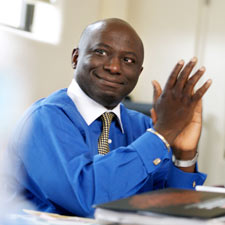Known officially as the “Sino-American 1+2+1 Dual Degree Program,” the initiative provides for Chinese students to matriculate their freshman year at their native school, spend the two middle years at HSU, then return to China for their senior year and earn bachelor’s degrees from both universities.
China’s partner schools are Changshu Institute of Technology, Dali University, Henan Polytechnic University, Henan University, Henan University of Technology, Inner Mongolia University, Inner Mongolia University of Science and Technology, Jilin Institute of Chemical Technology, Long Dong University, Nanjing University of Technology, Nanyang Normal University, Pingdingshan University, Tianjin Institute of Urban Construction, Tianjin University of Science and Technology, Yangzhou University, Zhengzhou University of Light Industry and Zhongyuan University of Technology.

Professor Guy-Alain Amoussou, Director of HSU International Programs, said Humboldt State and its partners will agree to mutual academic credit acceptance and transfer, which will involve the articulation of curriculum. “HSU will ensure that the Chinese students meet the necessary English proficiency,” he said.
Initially, available majors will be biology, business, chemistry, computer science, computer information systems, English, international studies, mathematics, physics and psychology.
Beyond the attendance of Chinese students at Humboldt State, the dual-degree agreements will help foster international activities, such as faculty and student exchanges, Dr. Amoussou said. “It will also bolster collaborative research and the establishment of a strong Chinese program at HSU.”
The multiplying partnerships will reinforce Humboldt State’s long-term and accelerating drive to internationalize the campus and encourage diversity and multicultural learning. Today, HSU has approximately 55 international students from multiple countries, up from about 35 three years ago.
The new partnerships also buttress the University’s substantial enrollment gains in 2006 and 2007. Professor Amoussou said HSU is prepared to welcome up to 60 students each year through the dual-degree program, beginning with the Fall 2008 semester. The 60-ceiling is a trial and likely to rise as the program matures. An International House is incorporated in on-campus residence to accommodate both international and American students and establish cross-cultural living experiences.
The 17 accords stem from HSU’s selection in 2006 among five additional institutions in the United States named to participate in the Sino-American “1+2+1” initiative by the American Association of State Colleges and Universities (AASCU), in tandem with the China Center for International Education Exchange (CCIEE).
The AASCU has 430 public college and university members from the United States, Guam, Puerto Rico and the Virgin Islands. Its charter is to strengthen academic quality, generate professional development opportunities for high ranking academic leaders, analyze public policy and advocate for member institutions and the students they serve.
The CCIEE, headquartered in Beijing, is a non-profit organization founded in 1981 and registered with the Ministry of Civil Affairs. It promotes the advancement of education, culture, science and technology and provides professional guidance and coordination to its 145 member institutions.